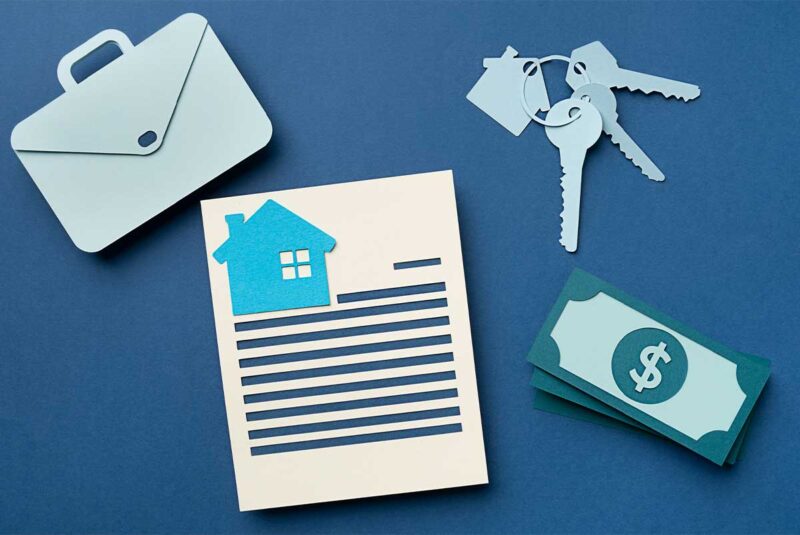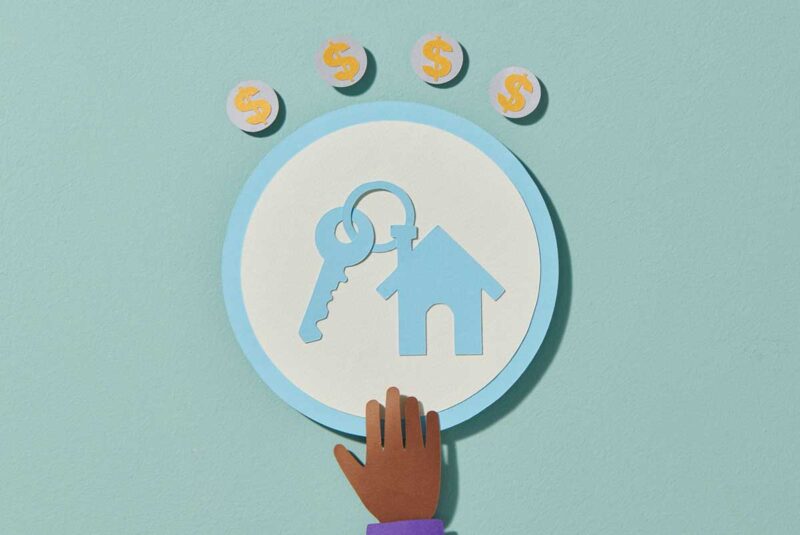Ready To Buy a Home?
Get Approved to Buy a Home
Rocket Mortgage® lets you get to house hunting sooner.
If you take out a mortgage on a home, you might be surprised to receive your first bill from a bank you’ve never worked with before. You can thank the secondary mortgage market for that.
When you take out a home loan, your lender can sell the loan – and the rights to collect payments and interest – to a different financial institution. Lenders usually sell the loan for a small profit before repeating the process of issuing and selling other home buyers’ loans.
For most borrowers, the secondary mortgage market has no direct impact on their loans – other than the name of the bank servicing it. Still, you might want to know more about how the secondary mortgage market works and its important role in the mortgage industry.
What Is the Secondary Mortgage Market?
The secondary mortgage market is where financial institutions buy and sell home loans and the rights to service those loans.
Lenders and financial institutions use the secondary mortgage market to sell loans they don’t want to hold – or to buy loans or loan servicing rights.
The secondary mortgage market is an essential part of the mortgage industry because it allows mortgage lenders to recoup the costs of loans they issue.
You might be asking why the bank needs to get their money back since borrowers pay them back with interest. Good question.
Because the 30-year fixed-rate mortgage is one of the most common home loans, banks often have to wait a long time to get their money back. If banks regularly issue new loans but don’t get their investment back until several decades later, they might run out of money to fund new loans.
They’d also be taking on a lot of risk by holding every mortgage they issue. Banks could run into financial trouble if a recession hits or borrowers fail to make their mortgage payments on time.
The secondary mortgage market helps lenders reduce risk and allows them to replenish capital (money) quickly so they can continue issuing new mortgages. It also clears the way for government agencies and government-sponsored enterprises (GSE) to securitize mortgages by packaging loans into mortgage-backed securities (MBSs).
But what do all these names mean and what specific role does each play in the secondary mortgage market? Let’s break it down.
What is a GSE?
GSEs are entities that improve credit and make more capital available to certain parts of the economy (like the mortgage industry). GSEs are also mortgage aggregators, which means they bundle a group of loans together to sell them to investors, known as MBSs. The best-known examples of GSEs are Fannie Mae and Freddie Mac.
In the case of Fannie Mae and Freddie Mac, the government doesn’t own these organizations – though they did create them. Rather, the U.S. Federal Housing Finance Agency (FHFA) serves as conservator of these entities,[1] ensuring they’re financially stable and continue operating smoothly.
GSEs like Fannie and Freddie guarantee loans that meet their standards (aka conforming loans), insuring investors receive on-time payments.[2]
Within the secondary mortgage market, GSEs buy eligible loans from lenders, choosing to either package the loans into MBSs for investors to buy or keep them in their own portfolios.
Though GSEs and government agencies, like the Federal Housing Administration (FHA), account for buying and selling most mortgages on the secondary market, there may be other mortgage aggregators who buy loans and package them as MBSs to sell.
What is a mortgage-backed security?
A MBS is a bond that’s tied to a group of mortgages. Investors can buy MBSs when they want to invest in a pool of mortgages. As borrowers repay their mortgage debt over time, investors who own MBSs receive monthly payments (aka coupons) consisting of principal and interest payments.[3]
What is the difference between the primary and secondary mortgage market?
When borrowers want to take out a mortgage to buy a home, they go to mortgage lenders. This is known as the primary mortgage market. The secondary mortgage market is where lenders and other financial institutions buy and sell packages of mortgages, returning liquid capital that lenders can use to keep issuing home loans on the primary market.
How Does the Secondary Mortgage Market Work?
The secondary mortgage market can be complicated, but it tends to follow the same general pattern, moving through a cycle of the following four steps:
- Lender approves the loan: A lender approves a borrower’s mortgage application, and the borrower agrees to the loan terms.
- Lender sells the mortgage on the secondary market: Once a loan is issued, the lender can go to the secondary mortgage market and sell the loan to GSEs, like Fannie Mae and Freddie Mac.
- Loan is packaged by a GSE: GSEs (or another aggregator like a government agency) take the loan and others they’ve purchased and pool them together into bonds known as MBSs. Most MBSs are made up of mortgages with a similar risk level.
- Investors buy the packaged mortgages: Investors buy these mortgages by investing money in MBSs, replenishing the GSE’s capital and allowing them to buy more loans and repeat the cycle.
What’s the Purpose of the Secondary Mortgage Market?
The secondary mortgage market keeps the mortgage industry liquid, affordable and stable. This benefits lenders (aka mortgage originators), borrowers and investors.
The Great Depression resulted in roughly 25% of American homeowners succumbing to foreclosure and losing their homes.[5] Banks failed and didn’t have the money to issue new mortgage loans, which highlighted the instability of the mortgage market.
In response, Congress established the secondary mortgage market by creating Fannie Mae in 1938 (and Freddie Mac 32 years later).[6] The goal of these entities is to stabilize the mortgage market, increase liquidity for lenders and encourage homeownership by making home loans more affordable for borrowers.
Benefits for lenders
Lenders benefit from the secondary mortgage market because it keeps them flush with liquid capital and offers a guaranteed buyer for the mortgages they issue to borrowers. This helps lenders control risks, maintain stability and allows them to sell mortgages and mortgage servicing rights.
Benefits for investors
Virtually anyone can invest in the secondary mortgage market. Examples include individuals, corporations, institutions, hedge funds, pension funds (or mutual funds) and governments. The secondary mortgage market makes it easy for investors to research and invest in the types of MBSs that best suit their needs.
MBSs can serve as an alternative investment to government bonds, often yielding higher returns than fixed-income assets, like I bonds.
Benefits for borrowers
Though borrowers don’t interact directly with the secondary mortgage market, they still benefit from it. The secondary mortgage market contributes to making mortgages more accessible and affordable.
Pros and Cons of the Secondary Mortgage Market
The secondary mortgage market is an important contributor in promoting economic stability, but it’s not a perfect solution. Let’s discuss the pros and cons of the secondary mortgage market.
PROS of The Secondary Mortgage Market👍
The secondary mortgage market makes mortgages affordable for more people, encouraging homeownership.
Lenders are able to maintain liquidity, and so they can continue issuing new loans to borrowers.
The ongoing cycle of issuing, buying and selling mortgages helps stabilize the economy and housing market.
Those who want to invest in mortgages can do so through the secondary mortgage market. This market facilitates the creation of MBSs with ratings that tell investors the risk levels of different mortgage bonds.
CONS of The Secondary Mortgage Market👎
The secondary mortgage market played a significant role in the 2008 financial crisis. In an effort to keep up with high demand from investors, lenders issued subprime loans (loans issued to borrowers with low credit scores), and the rating agencies responsible for assigning risk levels of MBSs overstated borrowers’ ability to pay back their loans. When borrowers defaulted en masse, the housing market and mortgage industry collapsed, dealing an enormous blow to the entire economy.
When investors put their money behind MBS, they assume a certain degree of risk if borrowers fail to make their payments. If a large number of borrowers whose mortgages belong to a MBS fail to make payments, the entire MBS can default, potentially leaving investors holding the bag.
Since GSEs and government agencies only guarantee the purchase of mortgages that meet certain criteria, lenders often won’t issue loans that fall outside those parameters. Borrowers who don’t meet these criteria may have a difficult time getting approved for a mortgage.
Streamlining Mortgages for Borrowers, Lenders and Investors
The secondary mortgage market was created to help bring the dream of homeownership within reach for more people by making home loans more affordable. Though the underlying system of buying and selling mortgages on the secondary market is an imperfect one, it generally helps the economy and real estate markets operate smoothly and efficiently. As a result, homeownership is more affordable, lenders stay liquid and investors have ready access to MBSs.
Get approved to buy a home.
Rocket Mortgage® lets you get to house hunting sooner.
The Short Version
- The secondary mortgage market is where financial institutions buy and sell home loans and the rights to service those loans
- The secondary mortgage market helps lenders reduce risk and allows them to replenish capital (money) faster so they can continue issuing new mortgages
- Government-sponsored enterprises (GSEs) are entities that improve credit and make more capital available to certain parts of the economy (like the mortgage industry)
Federal Housing Finance Agency. “Conservatorship.” Retrieved October 2022 from https://www.fhfa.gov/Conservatorship#
Congressional Research Service. “The Loan Limits for Government-Backed Mortgages.” Retrieved October 2022 from https://sgp.fas.org/crs/misc/R44826.pdf
Financial Industry Regulatory Authority. “Mortgage-Backed Securities.” Retrieved October 2022 from https://www.finra.org/investors/learn-to-invest/types-investments/bonds/types-of-bonds/mortgage-backed-securities
Federal Reserve Bank of New York. “Mortgage-Backed Securities.” Retrieved October 2022 from https://www.newyorkfed.org/medialibrary/media/research/staff_reports/sr1001.pdf
Fannie Mae. “History.” Retrieved October 2022 from https://www.fanniemae.com/about-us/who-we-are/history
Federal Housing Finance Agency. “Fannie Mae and Freddie Mac.” Retrieved October 2022 from https://www.fhfa.gov/about-fannie-mae-freddie-mac




